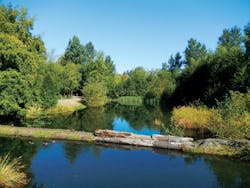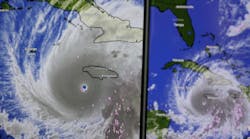Untapped Potential in Washington State
In the middle of a local business district in Mill Creek, Wash., sits Pond 6, a regional detention facility that was constructed well before the current western Washington flow control and water quality standards were put in place. The pond originally discharged into North Creek through two large outfall pipes at rates that led to erosion of the creek banks and reduced water quality due to minimal vegetative contact time. The pond had a capacity to hold approximately 6 ft of depth; however, the pond would only hold approximately a foot and a half during high flow conditions. On an average day, 6 in. was the norm.
“It really was just a flow-through pond,” said Derek Hann, design engineer for the Snohomish County Conservation District. “It had the capacity to hold and treat a lot of water, but the way it was functioning was just not living up to its full potential.”
“We realized that we couldn’t really retrofit the pond and meet today’s standards. We didn’t have the room to do that without purchasing the adjacent shopping center and tearing it down and making a much bigger pond,” said Scott Smith, city engineer for Mill Creek.
Because of the pond’s age, there were no historic design values by which to determine the flow rate through the pond. The conservation district installed monitoring devices to measure the depth of the pond, flow rate and rainfall intensity for a full year.
“It wasn’t really quantifiable,” Smith said. “We just knew that we needed to make some improvements and almost work backwards to try to maximize the pond the best we could.” The Thirsty Duck “was a good mechanism to do that,” he said.
Mill Creek was familiar with Thirsty Duck, as the systems have been installed throughout western Washington to reduce the size of storm water detention systems.
“Traditionally, the Thirsty Duck has been used for developers so they can make their ponds smaller, but alternatively, you can use Thirsty Duck to get the most out of an existing pond,” Hann said. “If you use it in a retrofit condition, you can get 30% to 35% more retention time in your pond than you would with a traditional control structure orifice system.”
Another factor that influenced Hann’s decision to choose Thirsty Duck was its ability to pass the base flow at a low elevation during the summer months.
“This allows vegetation to grow in the bottom of the pond that normally would not survive due to the deeper water conditions,” Hann said. “The much larger vegetated surface will significantly increase the water quality treatment capacity of the pond. It also ensures that most of the vegetation is rooted shrubs and grasses and not algae, which can do damage to the stream if it passes out the overflow.”
Hann worked with Thirsty Duck on several iterations of the design until an optimal control structure design was achieved. The project went out to bid in June 2014, and the system started up in August 2014. Overall, Hann is pleased with the system’s performance.
“I’ve been out there a couple of times when it has been raining and the water levels are much higher. After it stops raining, the water stays higher for a much longer period of time,” Hann said. “It’s holding way more water than it has in the past. There doesn’t appear to be any plugging or overflow issues. The connection to the stream was done really well, so the erosion issues we had in the past seem to have been totally fixed. I’ve been very happy with it.”
Download: Here


